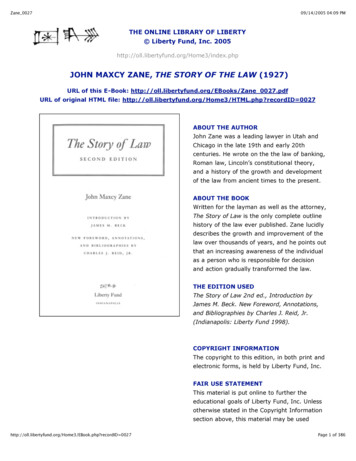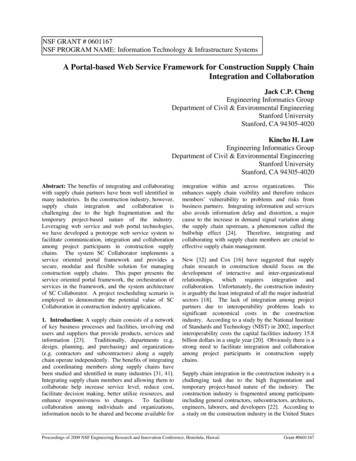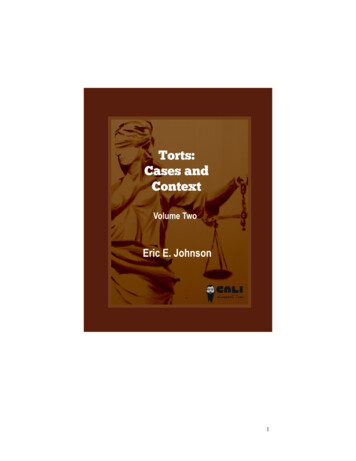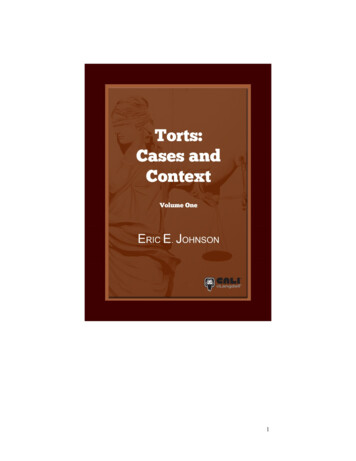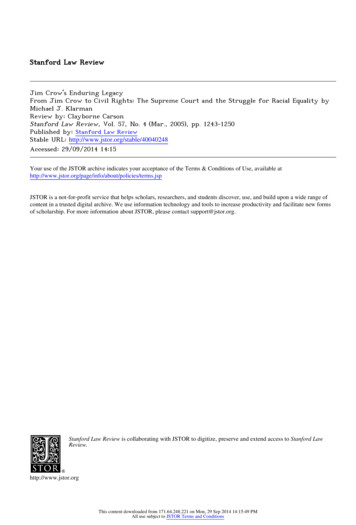
Transcription
Stanford Law ReviewJim Crow's Enduring LegacyFrom Jim Crow to Civil Rights: The Supreme Court and the Struggle for Racial Equality byMichael J. KlarmanReview by: Clayborne CarsonStanford Law Review, Vol. 57, No. 4 (Mar., 2005), pp. 1243-1250Published by: Stanford Law ReviewStable URL: http://www.jstor.org/stable/40040248 .Accessed: 29/09/2014 14:15Your use of the JSTOR archive indicates your acceptance of the Terms & Conditions of Use, available at ms.jsp.JSTOR is a not-for-profit service that helps scholars, researchers, and students discover, use, and build upon a wide range ofcontent in a trusted digital archive. We use information technology and tools to increase productivity and facilitate new formsof scholarship. For more information about JSTOR, please contact support@jstor.org.Stanford Law Review is collaborating with JSTOR to digitize, preserve and extend access to Stanford LawReview.http://www.jstor.orgThis content downloaded from 171.64.248.221 on Mon, 29 Sep 2014 14:15:49 PMAll use subject to JSTOR Terms and Conditions
Book ReviewJimCrow's EnduringLegacyClaybomeCarson*FromJimCrow to Civil Rights:The SupremeCourt and the StruggleNewYork:Oxfordfor Racial Equality. ByMichaelJ.Klarman.UniversityPress,2004.in cholarswritingThe formeror zeracial- the gradualrealizationof Americanegalitarianand ealisticreformers,ideals,whichis variouslyorthemass sonalAmericanand especiallyAfricanAmericanforcesof modernization.history,as a progressionfromslaverytofreedom,fromis understoodpervasivehistory,and discriminationto landmarkcivil rightsreformsandracial firmativepolicies.pessimistsof racial conflict,segregation,and inequality.discrimination,persistenceand federalcourtdecisionsforce,civil illexercisepoliticaldominanceon mostissuesofracialthatwhiteAmericanshave bettereducationaland economicopportunitiessalience,stillgenerallythando black Americans,and stilloftenresistconcertedeffortsto reduceKlarman'sFromracialMichaelJimCrowto Civillongstanding icofferingstrongcritiqueRightsof somecivilrightsadvocatesto relytoo muchon sues.litigationMartinLutherKing, Jr.,became thecentury,Duringthe twentiethX was ,prototypicalwas mostfamouslyexpressedhis pessimisticantagonist.King's optimismClayborne Carson is directorof the Martin Luther King, Jr.,Papers Project and aprofessorof historyat StanfordUniversity.He is senior editor of The Papers of MartinLuther King, Jr. (5 vols., 1992-2005) and coauthor of African American Lives: TheStruggle for Freedom (2004).1243This content downloaded from 171.64.248.221 on Mon, 29 Sep 2014 14:15:49 PMAll use subject to JSTOR Terms and Conditions
1244LAWREVIEWSTANFORD[Vol.57:1243whenhe announcedthatthisnationwouldat the1963Marchon Washington"oneday. . . riseup andliveoutthetruemeaningofitscreed:'We holdthesetruthsto be self-evident,thatall menarecreatedequal.'"1MalcolmX, forhiswasthatsuch a day would ever come. He c"as a sell-outbyKingandothermajorcivilrightsBut bothmen's viewsevolvedovertimeas King came to as a resultofa societythatgivessomanyNegroesthenaggingsenseof 'nobody-ness.'"2By theend of his tateswas "movingtowardtwosocieties,- separateandunequal."3black,onewhiteIn has expandedenormously,strugglehave outnumberedIt is notdifficultforoptimiststo pointto rformsofracistviolenceno theircivilrights.isnoSegregation longerlegallyracialallowedin tedStates.Significantchangeshavealso occurredofwhiteAmericans.in theBut pessimistsof whitesupremacycouldpointto ost-civilrightstwenty-firstcentury,to feelthe impactof whitepoliticaldominance,even if sbeenoffsettheVotingRightsActof 1965,theexpansionofblacksuffragewhiteby a majorshiftin thepoliticaland ideologicalallegiancesof southernvotersfroma New Deal-orientedDemocraticPartyto an increasinglycontinuedto nerallyDemocraticpresidentialcandidates,but no such candidatesince Lyndonhas attractedthesupportofthemajorityofwhitevoters.In thelargeJohnsonsectionsof theSouthand Westthatare now dominatedby alpoliticshas resultedin a shiftaway An ideologicalgulfnowseparates1. MartinLutherKing, Jr.,Speech at the Marchon Washington(Aug. 28, 1963),in A Call to Conscience: The Landmark Speeches of Dr. Martin LutherreprintedKing,Jr.75, 87 (ClayborneCarson& KrisSheppardeds.,2001).2. The Autobiographyof Martin Luther King, Jr. 266 (ClaybomeCarsoned.,1998).3. Nat'l Advisory Comm'n on Civil Disorders, Report of the NationalAdvisoryCommissionon Civil Disorders 1 (1968).This content downloaded from 171.64.248.221 on Mon, 29 Sep 2014 14:15:49 PMAll use subject to JSTOR Terms and Conditions
itytheroleof governmentin respondingto socialregardingneeds.Criticalracetheoristsare nderlyingof whitesupremacy.institutionalfoundationsThese theoristsquestionthenotionthatlaws prohibitingindividualacts of discriminationcan reverseofracialdominancethataresubtlethe(sometimes d historicallyentrenched(thereforebeyondthe reach of normallegalremedies).DerrickA. Bell, Jr.,a pioneerin thefield,has suggestedin substantialenduringgainsbecausewhiteAmericansto theirdominance.threatMorethantwodecadesago, Bell criticizedschoolthatlitigants"whofailto gthatreasonablypromisesto improvethe educationof black childrenserveboththeirclientsand theircause."4Bell's recentSilentCovenants:poorlyBrownv. Boardof Educationand the UnfulfilledHopesfor Racial to theby deprecating segregation.5MichaelJ.Klarmanpayslittleattentionto thecontributionsofthecriticalracetheorists,buthis iqueofferinglegalhe providesa wealthof historicalevidencethatwill informthethought,the relationshipbetweencivil rightslaw isdocumentedcontemporarythoroughlysurveyofin the twentiethcivil ighton topicsthathavealreadydrawntheattentionof severalsheddingof scholars.Likeotherscholars,Klarmanfocuseson CP lawyersto wnv. holarsinthefieldto equateprogressinblackcorrectswithchangesin nationalcivilrightslaw. examineawidebybroadening inquiryrangeofracerelationsrulingsby the SupremeCourt and to assess the indirectandof theserulingsas well as thedirectand intendedunintendedconsequencesones.FromJimCrowto CivilRightsis a workof enormousambitionand4. DerrickA. Bell, ServingTwo Masters:IntegrationIdeals and ClientInterestsinSchoolDesegregationLitigation,85 Yale L.J.470, 514-15 (1976), reprintedin CriticalRace Theory: The Key Writings That Formed the Movement 5, 18 (KimberleCrenshowetal. eds., 1995).5. Derrick A. Bell, Silent Covenants: Brown v. Board of Education and theUnfulfilled Hopes for Racial Reform(2004).6. 347 U.S. 483 (1954).This content downloaded from 171.64.248.221 on Mon, 29 Sep 2014 14:15:49 PMAll use subject to JSTOR Terms and Conditions
1246LAWREVIEWSTANFORD[Vol.57:1243in theerudition.It is certainto have lastinginfluenceon rtshiftedproposesto explainhowtheSupremeacceptanceof the separate-but-equalprinciplein its Plessy v. Ferguson1decisiontoa rejectionofthatprincipleinitsBrowndecision.His answertothis- "judicialdecisionmakinginvolvesa combinationquestionis hardlyoriginalof legal and politicalfactors"(p. 5)- but thisconclusionis supportedbycarefulexaminationsof dozensof SupremeCourtrulingsin theyearsfromKlarmanargues that thePlessy to Brown. Rejectinglegal tions raceencouragesjudgestoresolvethesequestionsin waysthatconformto edinpractices(p. 5). Ratherthanemphasizingthe Americanpolitical tradition,Klarman recognizesthat toppression.Asegalitarianismthe historianEdmundMorgan insistedin vilrightscouldneverbe ndblacksubjection.realityAn adinglitigationtrendin SupremeCourtdecisionsinthecenturyanda halfsinceDredScottv.whichheld thatAfricanAmericanswere neverintendedto beSandford,9"theBrowndrewamongPeople"envisagedas citizensby nsistthatAfricanupon subsequentwereentitledto "theequal protectionof thelaws,"10buttheSupremeCourtinDredScottwas icallytheFoundersconsideredAfricanAmericansto be "a subordinateandinferiorclass edsubjecttotheirauthority,butsuchas thosewho heldthepowerand n light of theBrown was gmaytheprincipleof originalintentthandidDred Scott.As ticeswhoweremostcommittedlegalsources,suchas ,precedent,thatonlyschoolsegregation"easycase- forsustaining(p. 447). He surmises7. 163U.S. 537(1896).8. EdmundMorgan, AmericanSlavery, AmericanFreedom( 1975).9. 60 U.S. 393(1857).10. 347 U.S. at495.11. 60 U.S. at 404-05.This content downloaded from 171.64.248.221 on Mon, 29 Sep 2014 14:15:49 PMAll use subject to JSTOR Terms and Conditions
March2005]JIMCROW'SENDURINGLEGACY1247fourof thenineSupremeCourtJusticeswould have favoredoverturningPlessysuitswerefirstconsideredin 1952 (p.whentheNAACP's schooldesegregation300). The FourteenthAmendmentwas by no means a clear basis foroverturningschool segregation,since, as Klarman points out, "the sameCongressthatwrotethe FourteenthAmendmentand was responsiblefor itsenforcementhad segregatedschools in theDistrictof Columbiafornearlyonehundred years, which implied that it considered segregation to beconstitutional"(p. 294). Klarmansuggeststhatthe major factorcausing theshiftfroma dividedCourtto theunanimousBrownrulingwas theintrusionofpoliticalconsiderationsintojudicial decisionmaking.The Justiceswere awareof the changes in Americanrace relationsand in the positionof the UnitedStates in world affairsthathad resultedfromWorld War II. They were alsoaware thata rulingby a dividedcourtwould encouragesouthernresistancetothedecision(p. 302).Klarman devotes careful attentionto the dilemma of Justice Felixwho consistentlyrejected the notion of judges "reading theirFrankfurter,into the Constitution"(p. 303) yet also "abhorredracialvaluespersonalhowever,recognizedthe significancesegregation"(p. 304). Even Frankfurter,of the changesthathad occurredin Americanracial relationsand attitudesinKlarmanargues,thejustices were partof athe postwaryears. Furthermore,culturalelite thatwas even more likely than the majorityof Americanstoacceptnotionsof racialequality(p. 309). He reportsthatof the SupremeCourtclerks,onlyWilliamRehnquist"seems to have favoredreaffirmingPlessy" (p.309). WhentheJusticesfinallyagreedto overturnPlessy,theyunderstoodthattheirdecision was not mandatedby a strictconstructionof constitutionallanguage, nor would it immediatelytransformAmerican race relations.Frankfurterwarnedthata desegregationdecision was "'not a wand by whichcan be accomplished'"(p. 311).thesetransformationsTo argue thateven SupremeCourtJusticespay attentionto politicalandsocial realities should hardly surpriseanyone familiarwith contemporaryscholarship in the field of constitutionallaw. The cautious process oftheBrowndecisionduringthe subsequentfivedecades providesimplementingof legal realismin Courtdecisionmaking.It is perhapsmoreevidenceampleremarkablethat breaks with precedent such as Brown quickly becomeprecedentsfor a new generationof legal formalists.Klarman suggeststhatand legal realism- and betweenstrictbetweentheextremesof legal formalismandjudicial activism lies a aveveryWhenthelaw is clear,judgeswillgenerallyto thecontrary.Whenthelaw is indeterminate,strongpersonalpreferencesjudgeshave littlechoicebutto makedecisionsbased on ferentweightsto thesetwoaxes,andfactorin decisionmakingto be legal,somejudgesmaydeema particularwhileotherswillregardthesamefactoras political.Thus,differentjudges,withthe same legal sourcesand holdingthe sameeven whenconfrontedThis content downloaded from 171.64.248.221 on Mon, 29 Sep 2014 14:15:49 PMAll use subject to JSTOR Terms and Conditions
1248STANFORDLAWREVIEW[Vol. 57:1243because theypersonalpreferences,mightreach differentlegal interpretationsthelegal and politicalaxes differently,prioritize(p. 5)But Klarman'sbook wouldnotbe as importantas it is if it lcontributiontopic.In myview,hismoreimportantis his assessmentbetweenthe Supremeof the lingsand thecontinuingrealityof racialinequalityAmerica.On thisquestion,Klarmanhas muchto say thatis originalandenlightening.Examiningnot only SupremeCourt decisionson schoolhe asks,butsegregation also decisionsin manyotherareasof racerelations,"How muchdid such Courtdecisionsinfluencethe largerworldof racerelations?"(p. 4). His answerto thisquestioncombineslegal,political,andin waysthatenricheach subdiscipline.social historyRatherthanseparatingcivil rightslitigationfromotheraspectsof the AfricanAmericanfreedomashe litigationstruggle,a distinctmethodof social protestand evaluatesits advantagesandhewritesdisadvantages,"(p. 7).- nAmericansindeedthatof nonwhiteswhenthetheworldthethroughoutduring but-equalruling.During- tainingattracting- becamean increasinglyof whitesfearamongpopulartool forinstillingAfricanAmericans.More thana thousandlynchingstookplace duringthe1890s alone. Klarmanquotes the pledge of South Carolina governor"Pitchfork"Ben Tillmanto personally"lead a mobin lynchinga negrowhohad committedan assaultupona whitewoman"(p. 11). In fsouthernwhitesthebysignaled generalunwillingnesswhitesto allow black votersto exercisepoliticalpower.The failureofPresidentWilliamMcKinleyto condemntheWilmingtonviolencewas rnreconciliation"politiciansto proceedwitheffortsto disenfranchisenearlyall blackvoters.In herwise.context,asserts,"Even had thesejusticesbeen bably"evenhavebeeninefficacious,"he writes(p. 59). elativelylittleeffecton thelivesof southernblacks.MostJimCrowlaws heCourtsignaledtheyproduce (p. 59). Thus,Supremeitswillingnessin Williamsv. Mississippi 2to acceptblackdisenfranchisementwhitesouthernershad ssageof new laws and icans."If the Court had invalidatedthe discriminatory12. 170U.S. 213 (1898).This content downloaded from 171.64.248.221 on Mon, 29 Sep 2014 14:15:49 PMAll use subject to JSTOR Terms and Conditions
nof literacytestsand orderedplaintiffsregistered,the decisionwould have had littleimpact,"Klarmanasserts."Few southernblacks had themoneyto litigatevotingrightscases, and in 1900 therewas no NAACP or anysimilarorganizationto offersupport.The willingnessof whitesto use violencewould have deterredmostblacks fromlitigation"(p.to suppressblack suffrage53).Even with the emergenceof the NAACP and its Legal Defense andEducation Fund, the Supreme Court's civil rightsrulingsdid littleto altertraditionalpatternsof racialoppression.WhilenotingtheNAACP's pioneeringtolegal victories,Klarmancalls attentionof opponents'resistance,the capacityof thefactorssuchas the intensitybeneficiariesof Courtdecisionsto capitalizeon them,theease withwhichare evaded,theavailabilityof veattractivenessof particularand aims,(p. 7)availabilityGiven that southernwhite resistancewas less ferventin areas such asof publicschools and otherfacilities,theSupremevotingthanin desegregationdecision had some impacton the southernwhiteCourt's Smithv. Allwright13thisbuteven"could not thwartthe obstaclestobreakthroughprimarysystem,blackvotingin theruralDeep South.Onlytheimpositionof thernblacks.Thatinterventionwas largelya consequenceof the southernblack protestmovement"(p. 253). In general,enforceableSupremeCourtdecisionson behalfof civil rightsrequiredthekindof progress in race relationsthat the decisions were intendedto secure.Klarmanadvises:is unlikelytohelpthosemostdesperatelyinneed.We rtlitigantsvictories,theymusthave a certainamountof powerin orderto enforcethem. . . ,requiresfromphysicaldanger,(p. 463)The Browndecisionservesas theprincipaltestof Klarman'soverallthesisbecause thatdecisionhas oftenbeen seen as shapingthechangesthatoccurredin Americanrace relations.He concedesthatBrowninspiredmuchofafterwardthe civil rightsactivism of the followingdecade (p. 381), but this factreinforceshis point that it was that activismratherthan the decision thatbroughtabout most of the changes. Moreover,Brown had the unintendedconsequence of radicalizingthe southernwhite opposition to civil rightsBrownincreasedthe likelihoodthatoncereform."By encouragingextremism,itwouldincitea violentresponse,"Klarmandirectaction protestdeveloped,thattookobserves(p. 385). The modestamountof publicschool desegregationplace in thedecade afterBrownmightwell have occurredin any case: "Brown13. 321 U.S. 649(1944).This content downloaded from 171.64.248.221 on Mon, 29 Sep 2014 14:15:49 PMAll use subject to JSTOR Terms and Conditions
1250LAWREVIEWSTANFORD[Vol.57:1243schoolsin border-statecities,but it was theSouth"completelyDeep(p. 454). As lateas ckstudentslater,segregated(p. predominantlyIf it is true,as Klarmancontends,that"theefficacyof Courtdecisionsonsocialandfactors"thenwhatshouldbe thedepends manypolitical(p. 462),betweencivilandothertacticsusedto ookabstainsfromtheactiviststanceof ebroadsuggestionsinthatshouldbe helpfultheandlimitationsof alternativestrategiesfordetermining strengthsAmericanrace relations."Constitutionaltransforminglitigationcan onlyredressthoseproblemsthataregroundedin law,"Klarmanconcludes(p. 461)."Becausewhitesupremacysocialdependedless on law thanon es,economicpower,ideology,couldproducewas inevitablylimited"(p. 461). hatabroaderoftacticsisoppression, suggests"Sit-ins,rangenecessary.FreedomRides,and tesjudgesrather(p. 467).Because his book is not a generaldiscussionof the modernAfricanAmericanfreedomstruggle,Klarmancan only offerhintsof a broaderthanrelianceonapproachto social themid-1960sweremorelitigation.Certainly, ficultto sustainand produceda nationalinsurgencieswhitebacklashthatwas evenmoreenduringthanwas dersof Klarman'sbookthereforewillfindlittlecause foroptimismthateffortsto overcomeracialinequityandoppressionin the UnitedStatescan ever proceedrapidly,giventhe deephistoricalrootsofwhitesupremacy.14. Gary Orfield & ChungmeiLee, Brownat Fifty:King's Dream or Plessy'sNightmare? (2004), available at /reseg04/resegregation04.php.This content downloaded from 171.64.248.221 on Mon, 29 Sep 2014 14:15:49 PMAll use subject to JSTOR Terms and Conditions
Jim Crow's Enduring Legacy From Jim Crow to Civil Rights: The Supreme Court and the Struggle for Racial Equality. By Michael J. Klarman. New York: Oxford University Press, 2004. Claybome Carson* Book Review Scholars writing about black-white relations in the United States typ








